My Town: Windsor
Where is My Town?
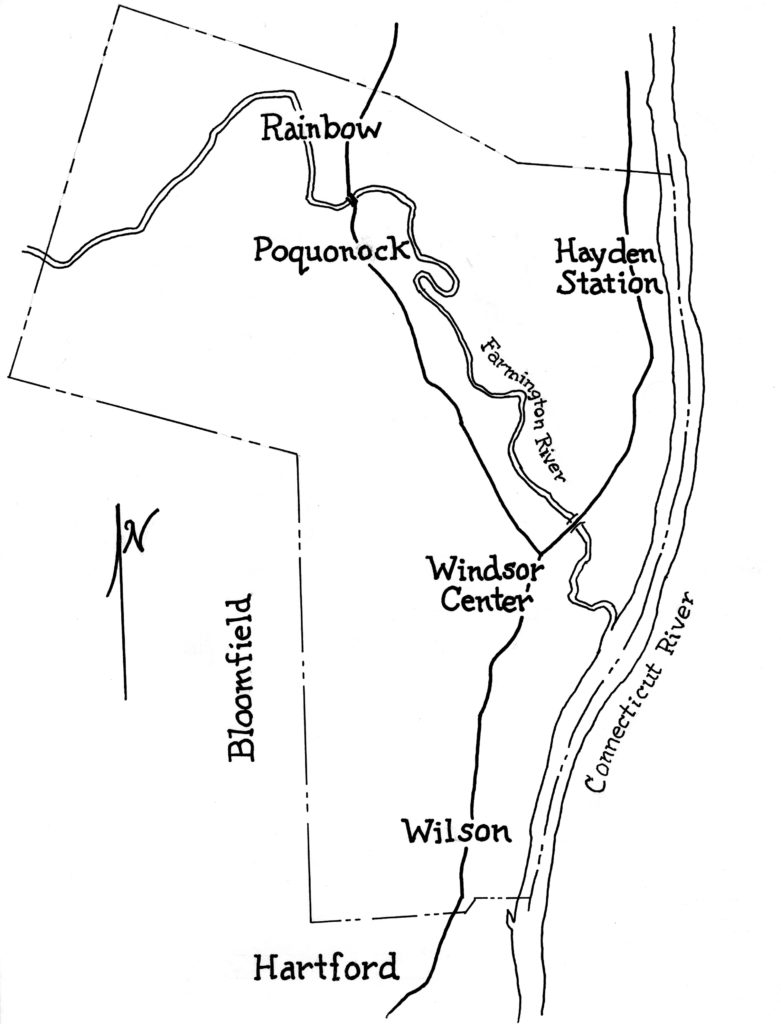
Map of Windsor today showing its five village centers. Windsor Historical Society
Windsor is on the Connecticut River. It is just north of Hartford. The Farmington River flows through it. This river location appealed to a group of English settlers. The land was good for farming. The rivers provided fish to eat. The rivers made travel and trade easy.
When first settled, Windsor was larger than it is today. The first settlers claimed a large area of north-central Connecticut. A smaller area became the town of Windsor in 1635.
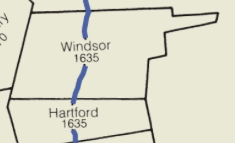
Windsor’s boundaries in 1635 when it became a town.
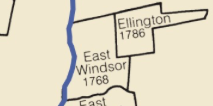 Over time, parts of Windsor split off to form new towns. The settlers on the east side of the Connecticut River split off first. They formed East Windsor in 1768. Ellington and South Windsor later split off from East Windsor. On the west side of the Connecticut River, Bloomfield and Windsor Locks split off from Windsor.
Over time, parts of Windsor split off to form new towns. The settlers on the east side of the Connecticut River split off first. They formed East Windsor in 1768. Ellington and South Windsor later split off from East Windsor. On the west side of the Connecticut River, Bloomfield and Windsor Locks split off from Windsor.
By the 1850s, Windsor had five village centers: Windsor Center, Wilson, Hayden Station, Poquonock, and Rainbow. They all exist today. Wilson and Hayden Station were railroad stops. Poquonock and Rainbow were mill villages.
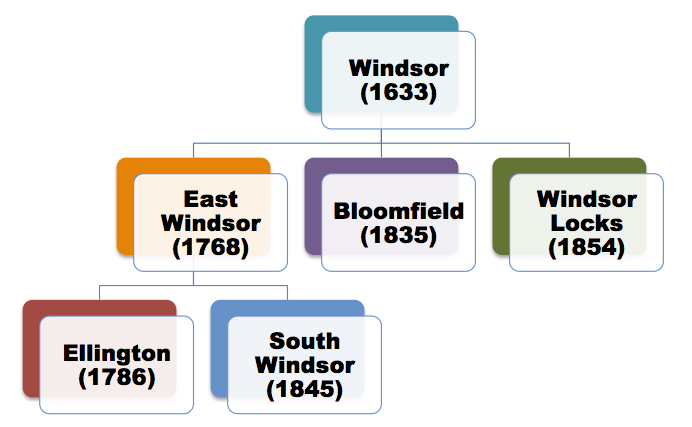
Windsor and the five towns that split off from it.
How was it founded?
The first people living in the area were the Poquonnoc and Podunk Indians. They farmed the land, fished, and traded furs along the rivers. They lived between two warring tribes. The Pequots lived to the east. The Mohicans lived to the west. The two tribes demanded gifts in exchange for peace.
In 1631, the Poquonnocs and Podunks asked the English for help. They travelled to the two English colonies in Massachusetts. They hoped the English would settle near them and help defend them against the Pequots and Mohicans.
The Dutch built a trading post near what is now Hartford in 1623. The English wanted their own trading post. William Holmes led a group from the Plymouth Colony in 1633. They traveled upriver past the Dutch fort. They arrived at what is now Windsor on September 26, 1633. Windsor became Connecticut’s first English settlement.
How do its residents make a living?
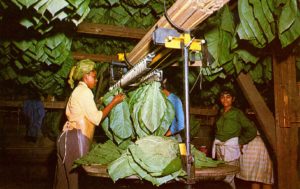
Working in a tobacco shed, Windsor, 2011. Windsor Historical Society
For most of its history, Windsor has been a farming community. It supplied Hartford with produce and dairy products. Tobacco has been an important crop.
Windsor was a vital river port. Merchants shipped timber, brick, livestock, wheat, tobacco, and produce. Their goods went to plantations in the West Indies. The merchants brought back sugar, molasses, salt, fabrics, and more. Windsor, like many towns in Connecticut, was part of the international slave economy.
Two developments hurt Windsor’s river trade. A drawbridge across the Connecticut River was built near Hartford in 1810. The railroad arrived in the 1840s.
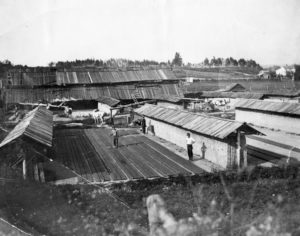
Mack brick yards, Windsor, 1954. Windsor Historical Society
In the 1800s, mills were built in the villages of Poquonock and Rainbow. The mills made wool, paper, and cotton. Bricks made in Windsor were used in buildings all over Connecticut.
In the 1890s, electric trolleys connected Hartford to Windsor. Town residents could travel to jobs in Hartford. In the 1960s, Combustion Engineering’s center for nuclear research employed 400 people in town.
How did it grow?
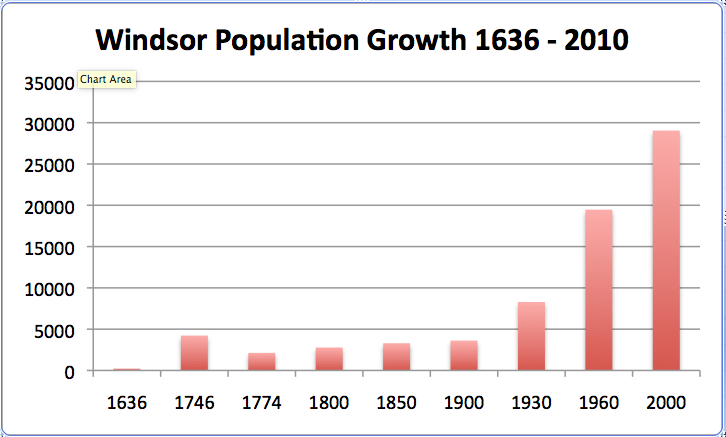 Windsor was first settled by 92 families. In the 1800s, immigrants from Ireland, Poland, and Lithuania came to work in the mills and on the farms. After World War I, college students came during their summer vacations to work in the tobacco fields. Some of those students were African-Americans from Virginia and Georgia.
Windsor was first settled by 92 families. In the 1800s, immigrants from Ireland, Poland, and Lithuania came to work in the mills and on the farms. After World War I, college students came during their summer vacations to work in the tobacco fields. Some of those students were African-Americans from Virginia and Georgia.
In 1930, Windsor’s population was 8,290 residents. The population increased rapidly through the 1950s. By 1960, it reached 19,467. In 2010, the population was 29,044.
Windsor’s population continues to become more diverse. In 2000, 27 percent of Windsor’s residents were African American, 5 percent were Hispanic, and 3 percent were Asian.
Who are its notable people?
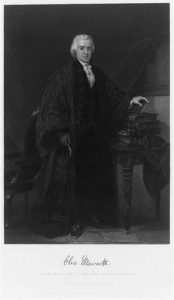
Oliver Ellsworth. Library of Congress
Among Windsor’s most famous residents was Oliver Ellsworth. He was a lawyer. He represented Connecticut in the Continental Congress from 1777 to 1783. He participated in the Constitutional Convention in 1787. He wrote the act that established the United States Federal Court System, and became the first Chief Justice.
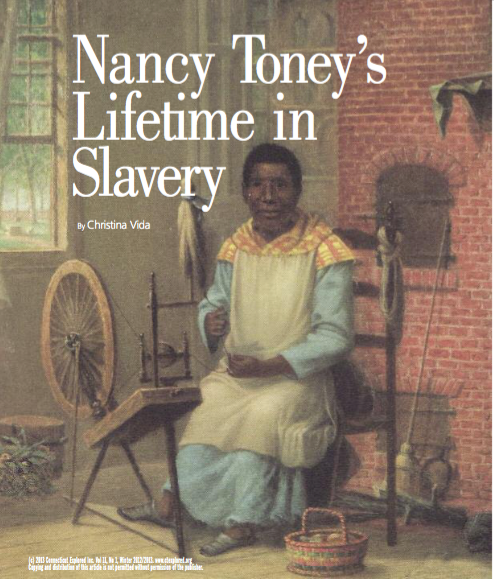
Artist Osbert Loomis imagined what Nancy Toney may have looked like in this painting from 1862. Loomis Chaffee School Archives. From Connecticut Explored, Winter 2012-2013
Nancy Toney lived most of her life in Windsor as an enslaved woman. She was owned by the Chaffee and Loomis families. She may have been the last enslaved person in Connecticut. She is listed in the 1820 census as enslaved but in the 1830 census as free. But there is no record of her being freed by the Loomises. Slavery was outlawed in Connecticut in 1848. She lived with the Loomis family until her death in 1857 at age 82. Her grave is in the Palisado Cemetery and is a site on the Connecticut Freedom Trail.
This essay was provided by the Windsor Historical Society, 96 Palisado Avenue, Windsor. Windsorhistoricalsociety.org
Visit TeachitCT.org for Windsor Historical Society’s field trips for third/fourth grade.




 Over time, parts of Windsor split off to form new towns. The settlers on the east side of the Connecticut River split off first. They formed East Windsor in 1768. Ellington and South Windsor later split off from East Windsor. On the west side of the Connecticut River, Bloomfield and Windsor Locks split off from Windsor.
Over time, parts of Windsor split off to form new towns. The settlers on the east side of the Connecticut River split off first. They formed East Windsor in 1768. Ellington and South Windsor later split off from East Windsor. On the west side of the Connecticut River, Bloomfield and Windsor Locks split off from Windsor.


 Windsor was first settled by 92 families. In the 1800s, immigrants from Ireland, Poland, and Lithuania came to work in the mills and on the farms. After World War I, college students came during their summer vacations to work in the tobacco fields. Some of those students were African-Americans from Virginia and Georgia.
Windsor was first settled by 92 families. In the 1800s, immigrants from Ireland, Poland, and Lithuania came to work in the mills and on the farms. After World War I, college students came during their summer vacations to work in the tobacco fields. Some of those students were African-Americans from Virginia and Georgia.
